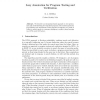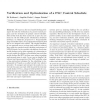ATAL
2008
Springer
14 years 5 months ago
2008
Springer
We explore the problem of specification and verification of compliance in agent based Web service compositions. We use the formalism of temporal-epistemic logic suitably extended ...
ASM
2008
ASM
14 years 5 months ago
2008
ASM
Abstract. In this paper we examine the difference between model checking high-level and low-level models. In particular, we compare the ProB model checker for the B-method and the ...
APN
2008
Springer
14 years 5 months ago
2008
Springer
Model checking is a powerful and widespread technique for the verification of finite distributed systems. However, the main hindrance for wider application of this technique is the...
AOSD
2009
ACM
14 years 5 months ago
2009
ACM
Cyber-physical systems increasingly rely on dynamically adaptive programs to respond to changes in their physical environment; examples include ecosystem monitoring and disaster r...
CAV
2010
Springer
14 years 5 months ago
2010
Springer
Abstract. We describe an interpolant-based approach to test generation and model checking for sequential programs. The method generates Floyd/Hoare style annotations of the program...
FOSSACS
2010
Springer
14 years 6 months ago
2010
Springer
A new framework for higher-order program verification has been recently proposed, in which higher-order functional programs are modelled as higher-order recursion schemes and then ...
ASM
2010
ASM
14 years 6 months ago
2010
ASM
Symmetry reduction is a model checking technique that can help alleviate the problem of state space explosion, by preventing redundant state space exploration. In previous work, we...
ICCD
1995
IEEE
14 years 6 months ago
1995
IEEE
Symbolic model checking is a successful technique for checking properties of large finite-state systems. This method has been used to verify a number of real-world hardware desig...
TACAS
2000
Springer
14 years 6 months ago
2000
Springer
This paper reports on experimental results with symbolic model checking of probabilistic processes based on Multi-Terminal Binary Decision Diagrams (MTBDDs). We consider concurrent...
SPIN
2000
Springer
14 years 6 months ago
2000
Springer
Abstract. We report on the use of model checking techniques for both the verification of a process control program and the derivation of optimal control schedules. Most of this wor...


